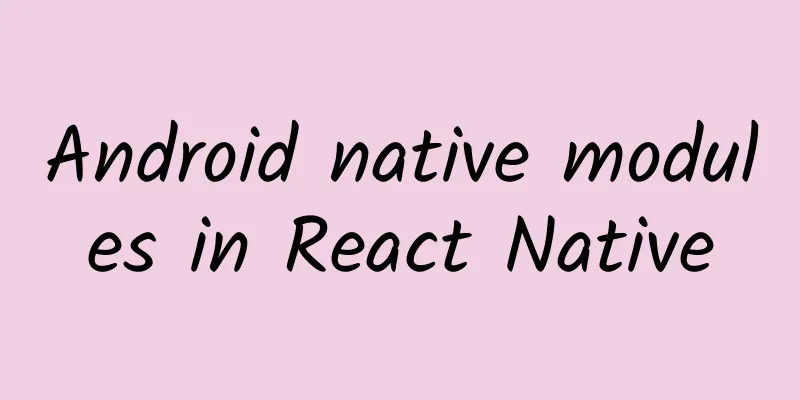Android native modules in React Native

|
When developing Android apps with React Native, you may need to use modules that are not encapsulated by React Native. But you can write native modules in Java and then selectively expose public interfaces to React Native. Let's try it together! What are we going to write? At the time of writing this article, React Native includes an ImagePickerIOS component, but there is no corresponding ImagePicker component on the Android platform. We will now build a simple ImagePicker for Android that is roughly similar to ImagePickerIOS. Writing an Android native module for React Native requires the following steps:
Let’s practice this together. Create a ReactPackage Launch AndroidStudio and navigate to MyApp/android/app/src/main/java/com/myapp/MainActivity.java. It should look like this:
Let's first import a package that has not yet been defined:
Now let's write that package. We'll create a new directory for it called imagepicker and write ImagePickerPackage:
Now we have created a package and included it in MainActivity. Create a ReactContextBaseJavaModule We will start by creating ImagePickerModule, which extends ReactContextBaseJavaModule.
This is a good start, in order for React Native to find our module from NativeModules, we need to override the getName method.
Now that we have a native module that can be imported by JavaScript code, let's make it do something interesting. Exposure method ImagePickerIOS defines an openSelectDialog method that can be passed a configuration object and callbacks for failure and success. Let's define a similar method in ImagePickerModule.
Here we import Callback and ReadableMap from React Native to correspond to function and object in JavaScript. We annotate this method with @ReactMethod so that it can be referenced by JavaScript as part of ImagePicker. In the method body we get the current activity, and if there is no activity, we call the cancel callback method. We now have a functioning method, but it doesn't do anything interesting yet. Let's use it to open the photo album.
First, we set up the callback, then we create an Intent and pass it to startActivityForResult. Finally, we wrap everything in a try/catch block to handle any exceptions that might occur. When you call openSelectDialog, you should be able to see an album. However, when you select a picture, the album does not do anything. In order to be able to process the image data, we need to handle the return value of the activity in the module. First, we need to add the activity event listener to the react context:
Now we can get the data returned by the album.
Here we should be able to get the image URI through the success callback.
To roughly mimic the behavior of ImagePickerIOS, we can allow the user to select an image, video, or open the camera directly. The writing of these functions is basically the same as above, and we will leave it as an exercise for the reader. |
<<: Contract Programming vs Defensive Programming
>>: Android Development Universal Rounded Corner ImageView
Recommend
Five major automotive technologies that may become popular in the future: autonomous driving is the core
Every year, CES is a rare technology event for th...
Implement national strategies and “supply” opportunities for the development of integrated national big data centers
On December 18, the "Accelerating the Integr...
There will be heavy to torrential rain in northern Hubei and other places. Which areas will be affected by the torrential rain?
There will be heavy to torrential rain in norther...
Manganese ore is not "fierce", but a little "cute"
Among all kinds of minerals, those named in the f...
Renesas Electronics plans to acquire IDT for $6.7 billion, targeting autonomous driving and the Internet of Things
The development direction of digitalization, inte...
New iPhones every year, but old scalpers every year: China's shameless buyers
The huge logo of Apple's Fifth Avenue flagshi...
[Creative Cultivation Program] Can "blood washing" therapy help lose weight and lower blood lipids? Dangerous! The truth is...
When the machine starts, the garbage in the blood...
China's preliminary plan for manned lunar landing announced! Plan to achieve lunar landing and scientific exploration before 2030
The China Manned Space Engineering Office announc...
Let the concept car hit the road! Roewe MARVEL X reaches 100 km/h in 4 seconds, redefining smart cars
The 2018 Beijing Auto Show is about to open. For ...
How long will it take for new mobile phone battery technology? Maybe 10 years!
"The batteries of digital devices are too sh...
"Sun God Clothes" are here! Chinese universities develop 24-hour constant temperature smart clothing, it's so cool
This winter is too cold. On December 16, the Cent...
Benefits for Android users: Ten major improvements in Google Android N
The online version of Forbes recently wrote an ar...
Don’t stick with one programming language for life
[[222139]] One of the key decisions we programmer...
The fourth issue of the Dragon and Tiger Song God main promotion system small circle (September-October 2021)
Resource introduction of the fourth phase of the ...









![[Dry Goods] How to get the first 1,000 valid users at low cost (full version)](/upload/images/67cc3fcec3c4f.webp)